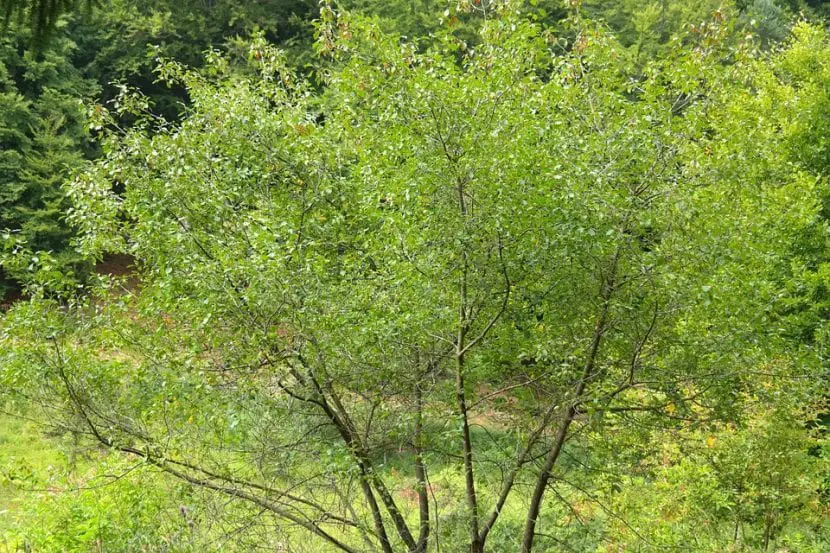
The cluster It is a plant that, in addition to being found in forests with acidic or neutral soils in Europe, is great to have in gardens or on patios and terraces. It doesn’t grow much; in fact, it does not usually exceed 6 meters in height, but it can be maintained at 3 meters and even less since it tolerates pruning very well.
Its fruits are very reminiscent of black cherries, but unlike these, they cannot be consumed. Let’s know more about him.
Origin and characteristics of the arraclán

It is a deciduous shrub native to Europe, Asia and North Africa that grows in gallery and riparian forests, as well as in oak groves, rocky areas and in humid areas. In Spain it is very common in the riparian forests of the extreme north of the peninsula, but we will also see it in the south, in the Central and Iberian Systems, and in the Montes de Toledo, Sierra Morena, Sierra de Cazorla and on the coast of Cádiz and Huelva. Its scientific name is frangula alnus (it is also accepted Rhamnus crushes) although it is known more as arraclán.
It reaches a height of 3 to 6 meters normally, but can exceed 10 and reach 15m if conditions are optimal. Its leaves are petiolate, green, being somewhat lighter on the underside. It blooms in spring. The flowers are small, composed of five pink or greenish petals. Once they are pollinated, the fruits develop that are rounded and brown when ripe.
It is a species that is in the catalog of threatened and protected species of the Valencian Community. And the subspecies Frangula alnus subsp. baetic it is threatened and protected in Spain.
What are their cares?
If you want to have a specimen of arraclán, we recommend providing it with the following care:
Location
It is a forest plant, so It must be in a bright area but without full sun. Ideally, it should be under the shade of tall trees (over 6 meters), especially if you live at a low altitude with respect to sea level.
Earth
- the garden: grows in acidic, neutral or siliceous soils, fertile and with good drainage. If the one you have does not meet any of these characteristics, don’t worry: dig a 1 meter x 1 meter hole, cover its sides with shading mesh (on sale here!) and then fill it with acidic plant substrate (for sale here!).
- Flower pot: fill with acidic plant substrate mixed with 30% perlite (for sale here!).
Irrigation

Image – Wikimedia Commons / Sten Porse
Frequent but avoiding waterlogging. During the driest and hottest season of the year you have to water an average of 3 times a week, while the rest of the year with 1-2 waterings a week you can have enough. But beware: take yourself and use this as a guide. Not all climates are the same, and even on the same plot, garden or balcony there may be microclimates.
I live on the Mediterranean coast, in the south of Mallorca (Spain), about 6km in a straight line from the coast, with temperatures of up to 38ºC in summer and a minimum of -1,5ºC in winter. Here the drought can easily last six months, so if you wanted to have a healthy cluster, probably 3 irrigations a week in summer would not be enough.
Therefore, it is important that you know a little about your climate (The basics, you don’t have to be a meteorologist 🙂; but more or less when it rains and when it doesn’t, when it’s cold and when it’s hot, what temperatures are reached in summer and which ones in winter,…). Plants depend on the climate: knowing the basics will help you enjoy not only the arraclán, but also gardening.
The more hot and dry, the more water needs the plants will have, since the soil dries more quickly.
Subscriber
From the beginning of spring to the end of summer, it is advisable to fertilize with organic fertilizers, such as guano or compost.

Related article:
The worm compost, a homemade invention
Multiplication
It multiplies by seeds in spring. For this you have to sow them for example in a seedbed tray (for sale here!) with substrate for acid plants, putting a maximum of two seeds in each alveolus. Bury them a little, enough so that they are not exposed, and once watered, place the seedbed outside, in semi-shade.
They will germinate in 1-2 weeks.
Pruning
The Arracklan pruned in late fall or late winter. You have to remove the dry, diseased, weak branches and those that are broken. If you see that one of them is getting too long, you can lower their height.
Use disinfected tools, for which you have to clean them before and after use with a few drops of dishwasher or pharmacy alcohol.
Rusticity
Resists up to -18ºC.
What uses is given to the arraclán?

Image – Wikimedia / Stefan.lefnaer
Ornamental
It is a very decorative tree, which gives good shade over time but it can also be had as a shrub. It is a bit demanding with which to the soil and the location, but in general it is a very grateful plant.
Dyes
Both the fruits and the bark of the trunk are used to give color; specifically, the fruits stain green, and the rind red.
Wood
The woody branches and the trunk are used to make tool handles. They are also good for producing fine charcoal.
Medicinal
All parts of the plant are toxic: if consumed they cause vomiting, nausea and serious problems; However, the extract of its bark is used as a purgative. Anyway, we advise not to ingest it without first consulting a doctor.
What did you think of frangula alnus?

